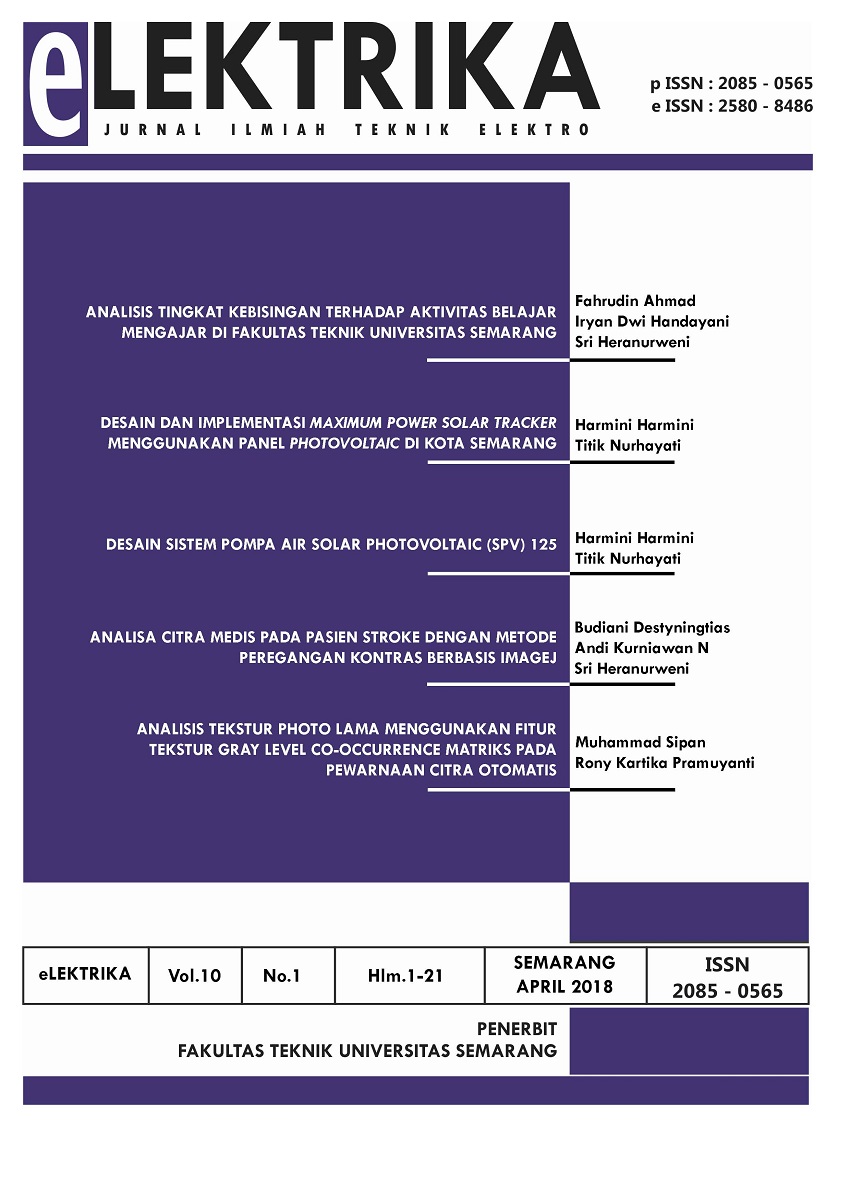DESAIN DAN IMPLEMENTASI MAXIMUM POWER SOLAR TRACKER MENGGUNAKAN PANEL PHOTOVOLTAIC DI KOTA SEMARANG
DOI:
https://doi.org/10.26623/elektrika.v10i1.1117Keywords:
MPPT, Solar Photovoltaic, Tracking.Abstract
The purpose of this research is to design and implementation Maximum Solar Power Tracking system using photovoltaic panel, in order to increase solar panel efficiency and power. Data collection is done for the condition in Semarang city. The result of the research is expected to be base in planning of solar power system in Semarang city, whether it is for light-ing lamp planning and for Solar Home System (SHS). This MPPT system design uses standard 180 degree servo motor to drive photovoltaic panel and control circuit using ATmega IC, while simulation using MATLAB program. Tracking is done by online tracking method by moving the photovoltaic panel to the radiation of the sun. Tracking simulation is done with step 20, 50 and 180 step. The average of voltage generated by system without tracking is 3.97 Volt while the average volt-age generated by tracking system is 4.72 Volt. Efficiency between system without tracking and tracking system is 66.28% for tracking system and 78.78% for tracking system.
Keywords: MPPT,Solar Photovoltaic, Tracking.
Downloads
References
Akhiro Oi, 2002, Design and simulation of photovoltaic water pumping system, presented to the Faculty of California Polytechnic State University. Chang, Yuen-Haw, and Chang,Chia-Yu, 2010, Maximum Power Point Tracker of PV System by Scalling Fuzzy Control , Proseding IMECS, hongkong, March Gradi dkk, 2005, A MPPT Algorithm For Single Phase Single Stage Photovoltage Converter ,Dept.Of Electrical Engineering University of Bologna. Harmini, 2010, Optimasi dan implemetasi MPPT (Maximum Power Point Tracker) DC-DC Converter pada sistem photovoltaic , Department of Electrical Engineering, Universitas Semarang
PV Tracking
Harmini, Nurhayati, 2012, Implementasi MPPT (Maximum Power Point Tracker) pada sistem PV (Photovoltaic) , Department of Electrical Engineering, Universitas Semarang. Harmini, Nurhayati, 2014 Implementasi Inverter dan MPPT (Maximum Power Point Tracker) pada sistem On Grid PV (Photovoltaic) , Department of Electrical Engineering, Universitas Semarang. Harmini, Nurhayati, 2015 Optimasi MPPT pada sistem PV menggunakan algoritma Incremental Conductance , Prosiding Information Technology and its Application Towards the Implementation of Green Technology The 1st Conference on Information Technology, Computer and Electrical Engineering (CITACEE 2013), ISSN:23385152 Harmini, Nurhayati, 2013 Aplikasi MPPT Fuzzy Logic Control (FLC) untuk pembangkit terdistribusi pada sistem on grid PV (Photovotaic) , Jurnal Pengembangan Rekayasa dan Teknologi, Vol 15, No 2,ISSN 1410-9840. Jiang, dkk 2005, Maximum Power Tracking for Photovoltaic Power System, Journal of Science and Engineering,vol.8,No 2,pp.147-153(2005). D.C Riawan, Nayar, 2008 Design and Implemantation of P-I based MPPT scheme for PV modules Operated on Wide Temperatur Range, Department of Electrical & Computer Engineering, Curtin University of Technology Australia Frankly, 2013 Simulation of a Sun Tracking Solar Power System , 120th ASEE Annual Conference & Exposition, June 23-26,2013 S.Saravanan, Ramenh Babun, Maximum power point tracking algorithms for photovoltaic system-A review , Renewable and sustainable energy reviews, Volume 57, may 2016,pages 192-204. http//desain-sistem.blogspot.co.id/2017/03/Aplikasi motor servo pada mikrokontroller.html diakses pada 27 Juli 2017 pukul 00.15
Downloads
Published
Issue
Section
License
Authors who publish this journal agree to the following terms:
The author owns the copyright and grants the journal the first publication rights with the work simultaneously licensed under the Creative Commons Attribution 4.0 International License which allows others to share the work with recognition of the authorship of the work and initial publication in the journal.
Authors may enter into separate additional contractual agreements for non-exclusive distribution of the published journal version of the work (e.g., posting it to an institutional repository or publishing it in a book), in recognition of its initial publication in this journal.
Authors are allowed and encouraged to post their work online (e.g., in institutional repositories or on their websites) before and during the submission process, as it can lead to productive exchanges, as well as earlier and larger citations of published works (See The Effects of Open Access).

This work is licensed under the Creative Commons Attribution 4.0 International License.











